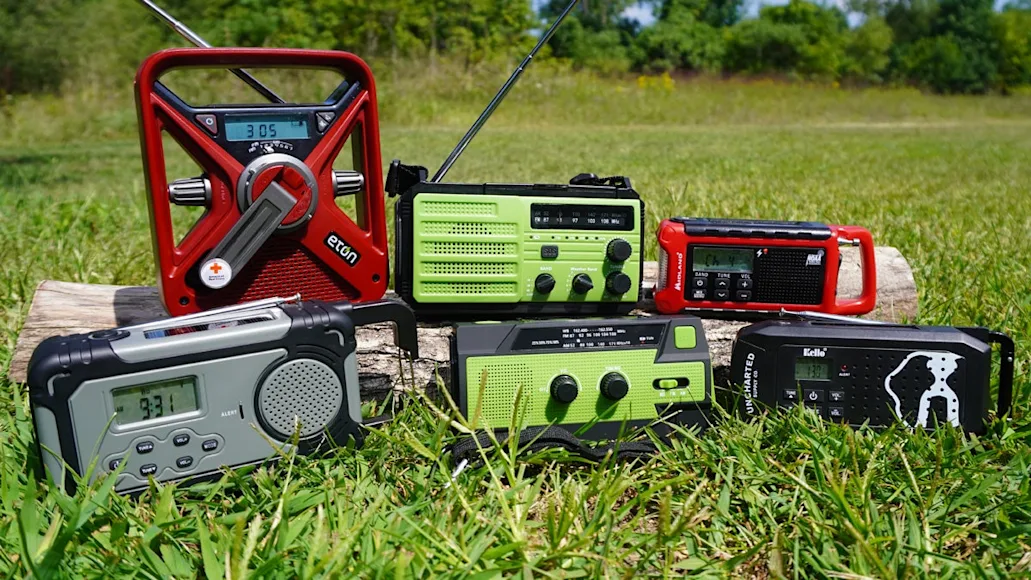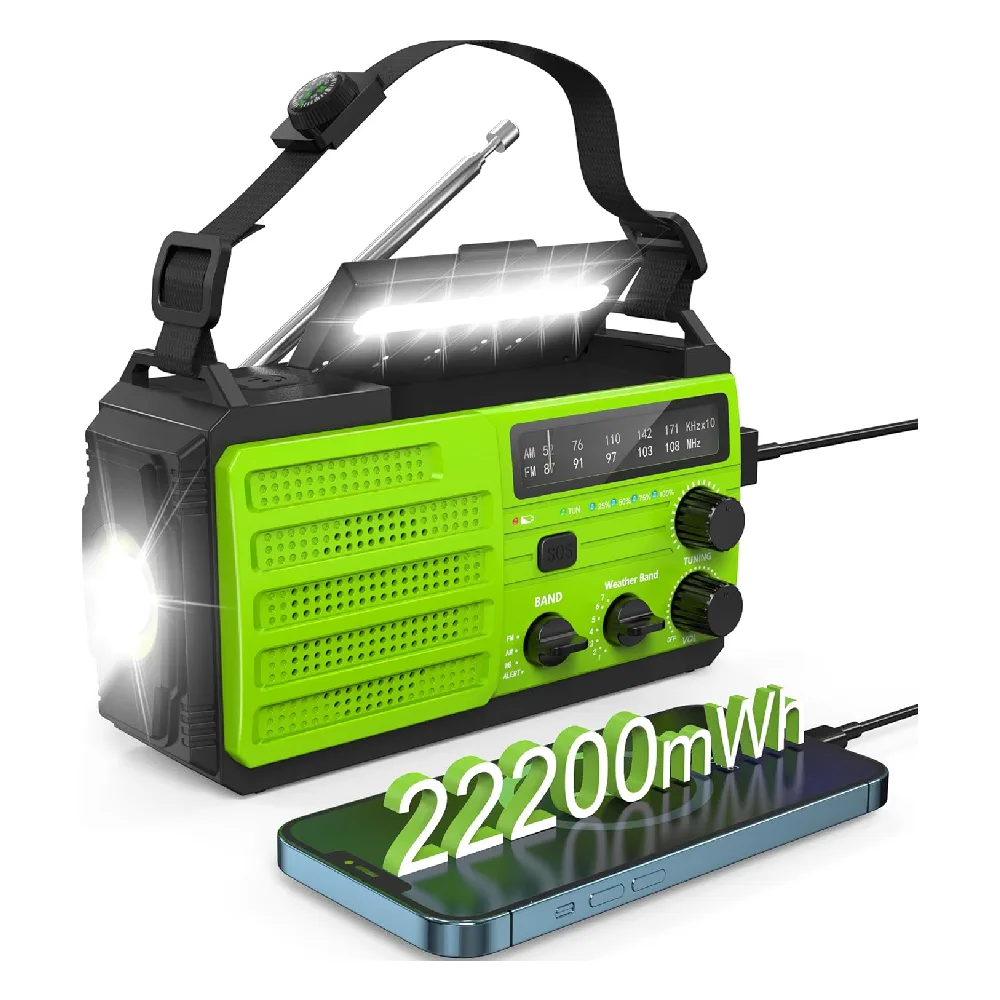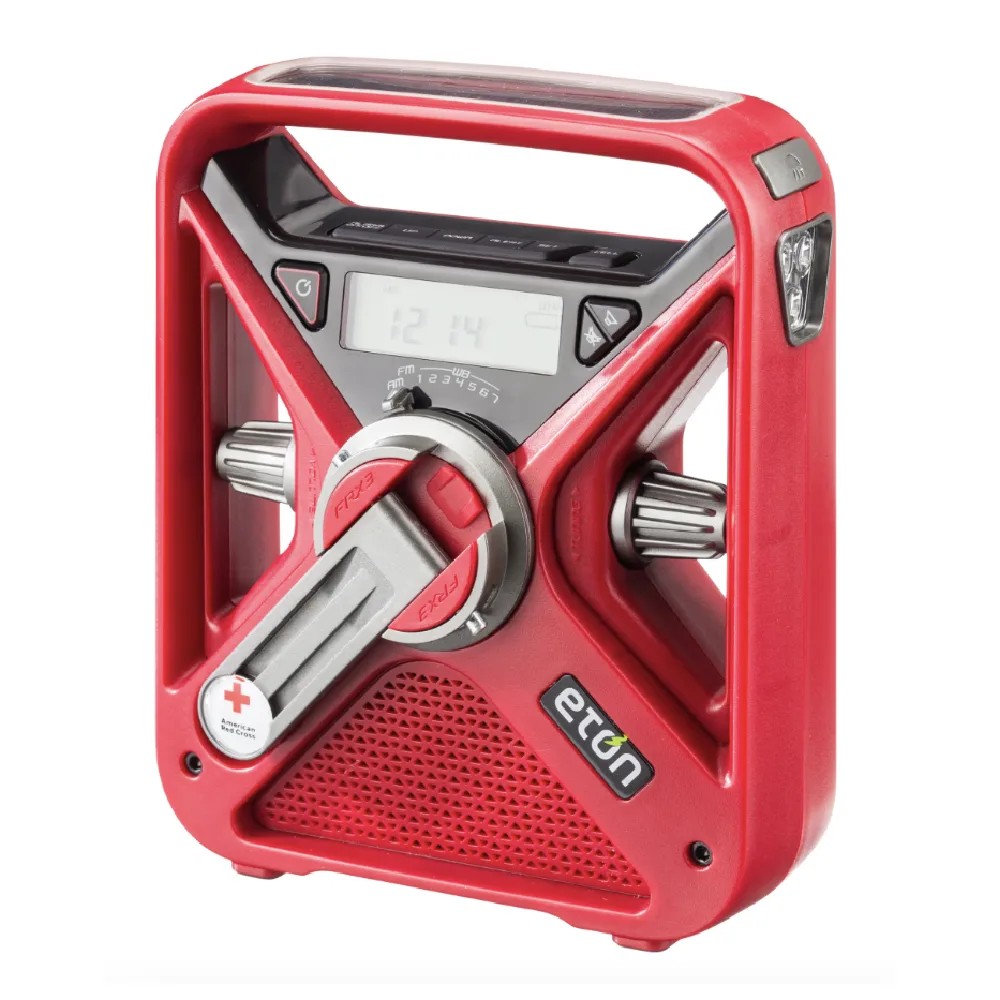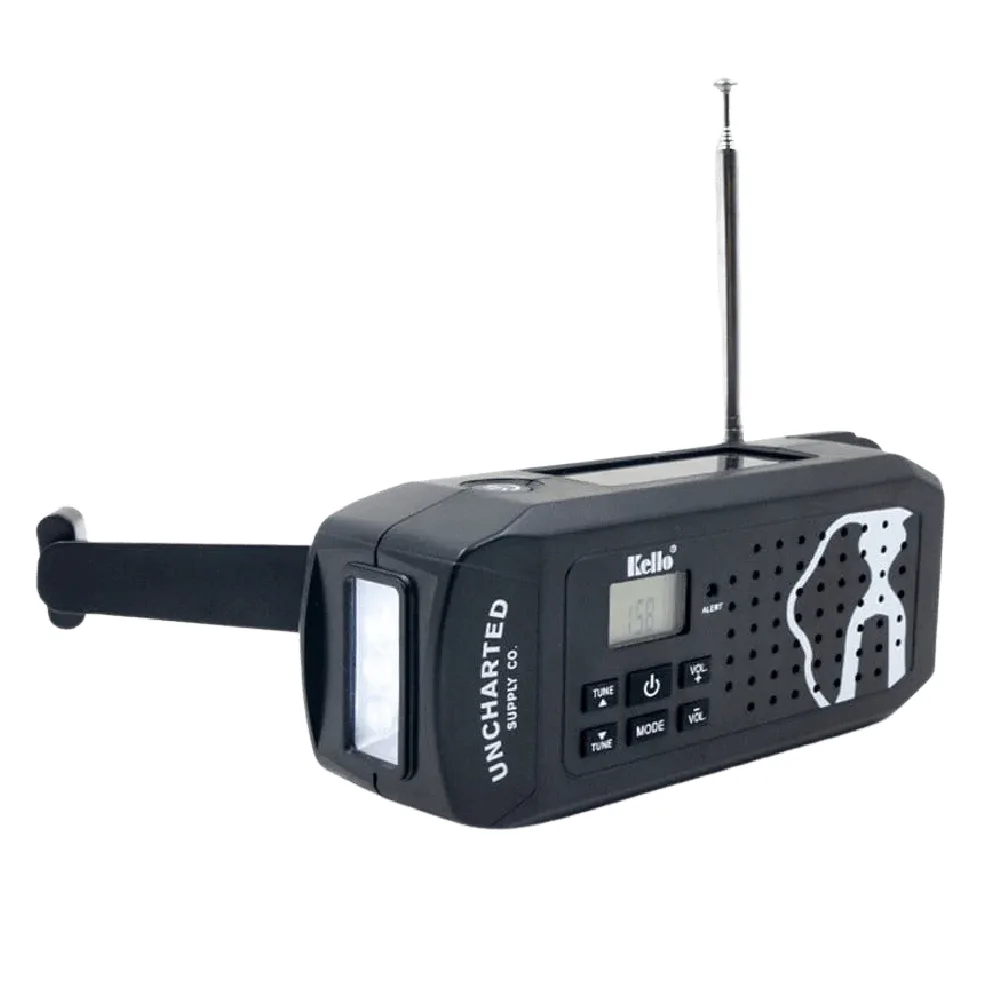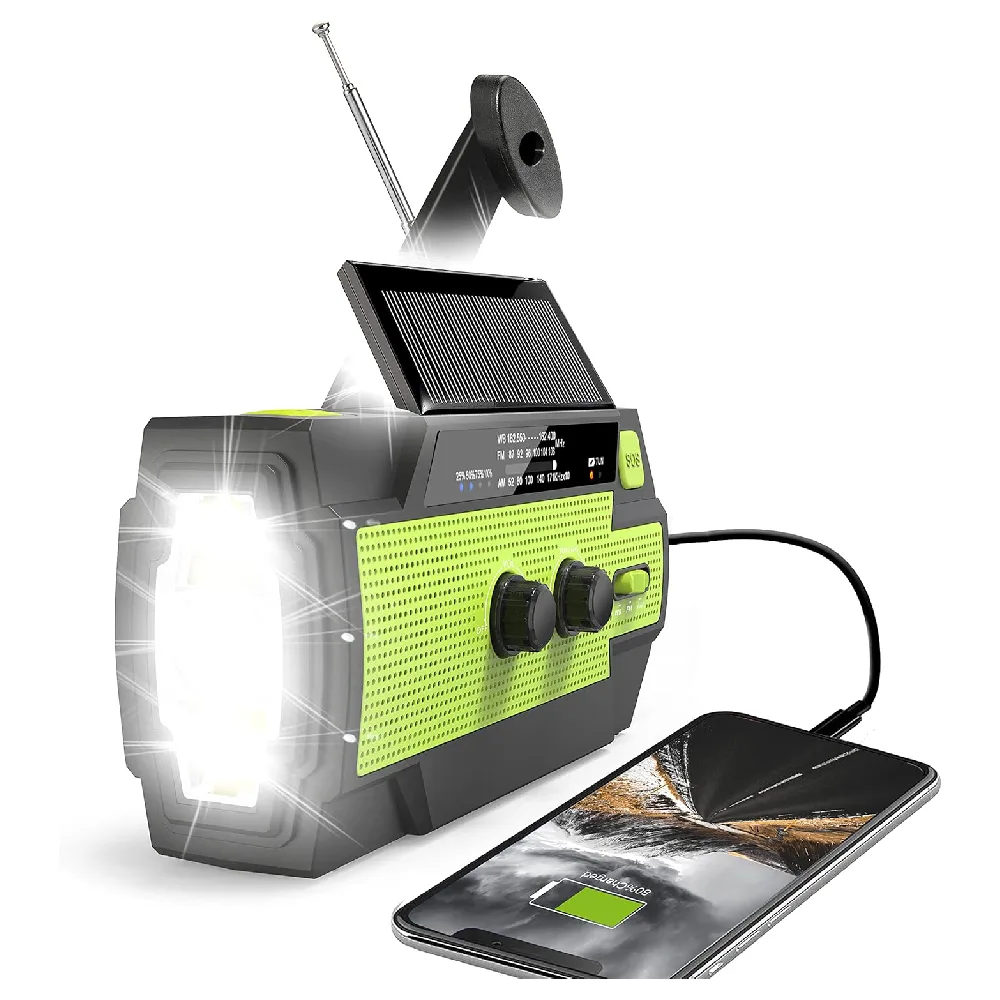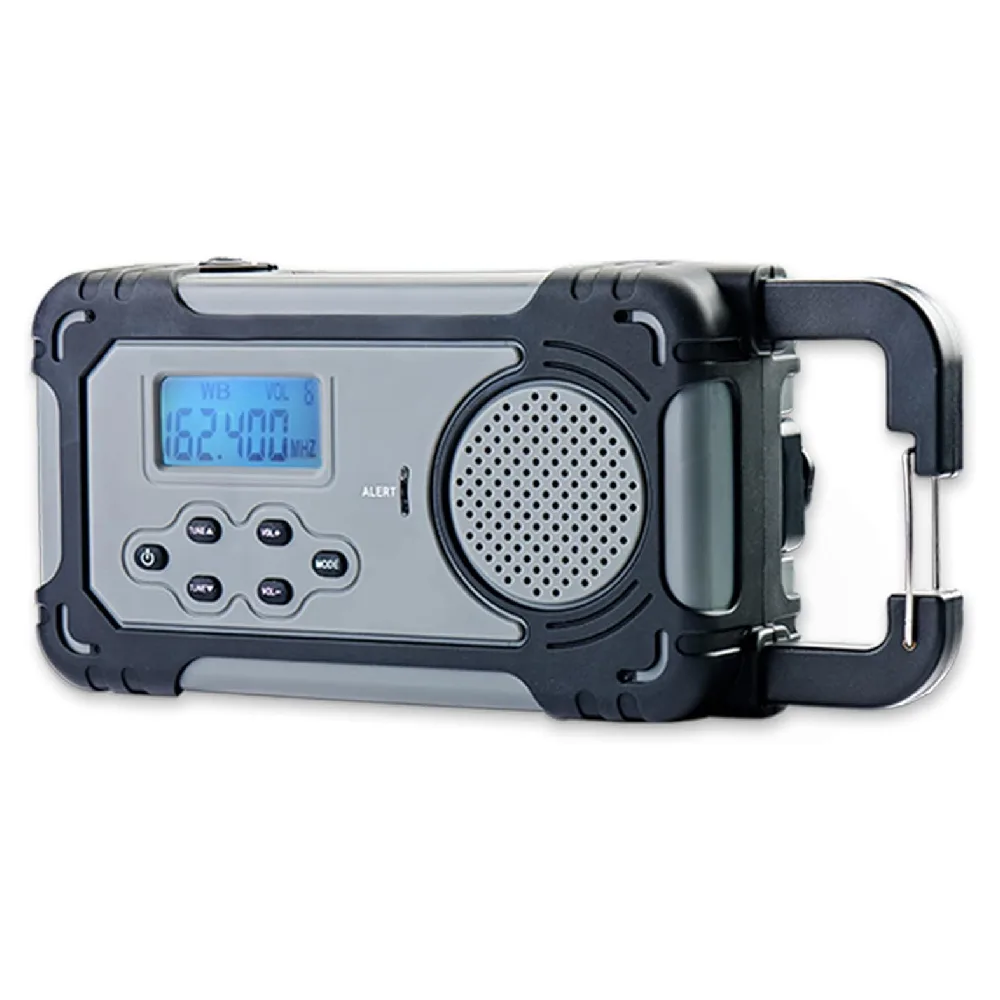We may earn revenue from the products available on this page and participate in affiliate programs. Learn more
A good weather radio is a must-own these days, especially considering today’s unpredictable climate. Unexpected natural disasters can strike quickly and cut off vital lines of communication. Hurricanes, tornados, blizzards, floods, and earthquakes are just some of the natural disasters everyone should prepare for. Fortunately, a weather radio can convey vital pieces of information when the internet and cell phone networks fail.
The great news is that today’s weather radios are extremely affordable, so there’s really no excuse to not have at least one in your home in your home survival kit in case disaster strikes. We took the time to test out six of the most popular options available to see if they live up to the hype—and which are the best weather radios you can buy.
Best Overall: Givoust Emergency Weather Radio
Best Portable: RunningSnail Emergency Crank Radio
Best for Home: Eton American Red Cross FRX3+ Weather Radio
Best Backpacking: Midland ER210 Emergency Weather Radio
Best Budget: Uncharted Supply Co. NOAA Radio
Most Versatile: 4Patriots Liberty Band Emergency Solar Weather Radio
Best Overall: Givoust Emergency Weather Radio
Specs
Battery: 8000 mAh
Power: Solar, Hand Crank, USB
Weather Features: 7-Channel NOAA, AM/FM Radio
Additional Features: SOS Alarm, earphone jack, mini compass
Runtime: 24+ hours
Pros
Excellent sound quality
Very bright lights
Great antenna
Cons
Mini compass isn’t anything special

Most weather radios have a battery around 2000 mAh. Givoust stepped things up drastically with an 8000 mAh offering that gives this radio superior battery life to all the others on this list. I ran it for days without losing power once it was fully charged. And if you’re utilizing the hand crank and solar panel, you won’t need to worry about it running down very often. The antenna on this radio is very nice. I was easily able to listen to NOAA forecasts and AM/FM broadcasts while in my basement, away from the windows. This is the one to pick if you are concerned about getting a signal in a shelter or a canyon with steep walls. The sound is clear and crisp.
While the radio features are great, the lights of this radio are even better. The powerful flashlight feature on the front is blindingly bright. It has several different settings for lighting up a dark room. There’s also a nice little flip-up reading light that nicely illuminates the area around the radio. This is one I want to keep close for power outages. The SOS alarm is also extremely loud. It would be great to signal for help in a pinch.

The only complaint I have about the radio is that the compass on the strap isn’t anything special. It’s a standard, cheap compass that’s sold in the sporting goods section of every outdoor store. Everything else about this radio is top notch and very well designed. They used quality components for just about every aspect of this build. This radio charged my cell phone quickly while making almost no dent in its own battery.
Best Portable: RunningSnail Emergency Crank Radio
Specs
Battery: 4000 mAh lithium battery
Power: Solar panel, hand crank, USB
Weather Features: 7-channel NOAA radio, AM/FM radio
Additional Features: Flashlight, reading light, motion sensor light, SOS alarm
Runtime: 12+ hours
Pros
Great lights
Can charge a phone and listen to radio at the same time
SOS alarm is loud
Cons
Handle crank is a hair long
Sound quality could be better

I ran this radio for well over 12 hours straight without making much of a dent in the 4000 mAh battery. This is a great option for anyone who’s anticipating the possibility of multi-day power outages. I really liked the exceptionally bright LED flashlight and reading light on this radio, both of which are extremely bright and perfect for blackouts. Given the larger size of the battery, there’s less of a worry about running it down using these lights.
This radio features a dedicated SOS button that emits a loud siren. I like the fact Drained Snail made this a dedicated button instead of just incorporating the signal into the flashlight button. I didn’t have to worry about tripping the sound by accident either since the button needs to be held down a few seconds to activate it.
One standout feature I like better than the other radios is that fact that you can listen to it and charge a cell phone simultaneously. Most of the other radios on this list only you to do one of those things at a time.

This radio has a shorter antenna than I’d like, which slightly affects the sound quality. Expect a little bit of static in enclosed rooms. The crank handle also feels just a little too long when compared to other radios. This was my least favorite to crank.
Best for Home: Eton American Red Cross FRX3+ Weather Radio
Specs
Battery: 2600 mAh lithium battery
Power: Solar panel, hand crank, USB
Weather Features: 7-channel NOAA radio, AM/FM radio
Additional Features: Flashlight, SOS beacon, alarm clock
Runtime: 12+ hours
Pros
Change radio stations without losing weather band
Extremely long antenna
Great battery
Cons
Can’t run radio and charge a phone simultaneously

The Eton has one of the better antennas of all the radios I tested. I was easily able to pull NOAA weather reports in my basement with this radio. But I was also able to easily hear the Chicago AM sports radio station 670 the Score. That station is over 100 miles away (as the crow flies) from my home in southwest Michigan. The clarity of that station is usually hit or miss here on the other side of Lake Michigan. But I found it comes in quite clearly, even in the basement.
This radio’s battery life is great too. I ran it for well over 12 hours before I finally lost a single bar on the indicator. It will probably easily run for double that. I’m probably going to make this one a permanent addition to my van build due to the superior sound quality and range. It has a thinner profile than some of the other radios on this list, which should make it easy to stow under my driver’s seat or in the back of my kitchen cabinet in the van.
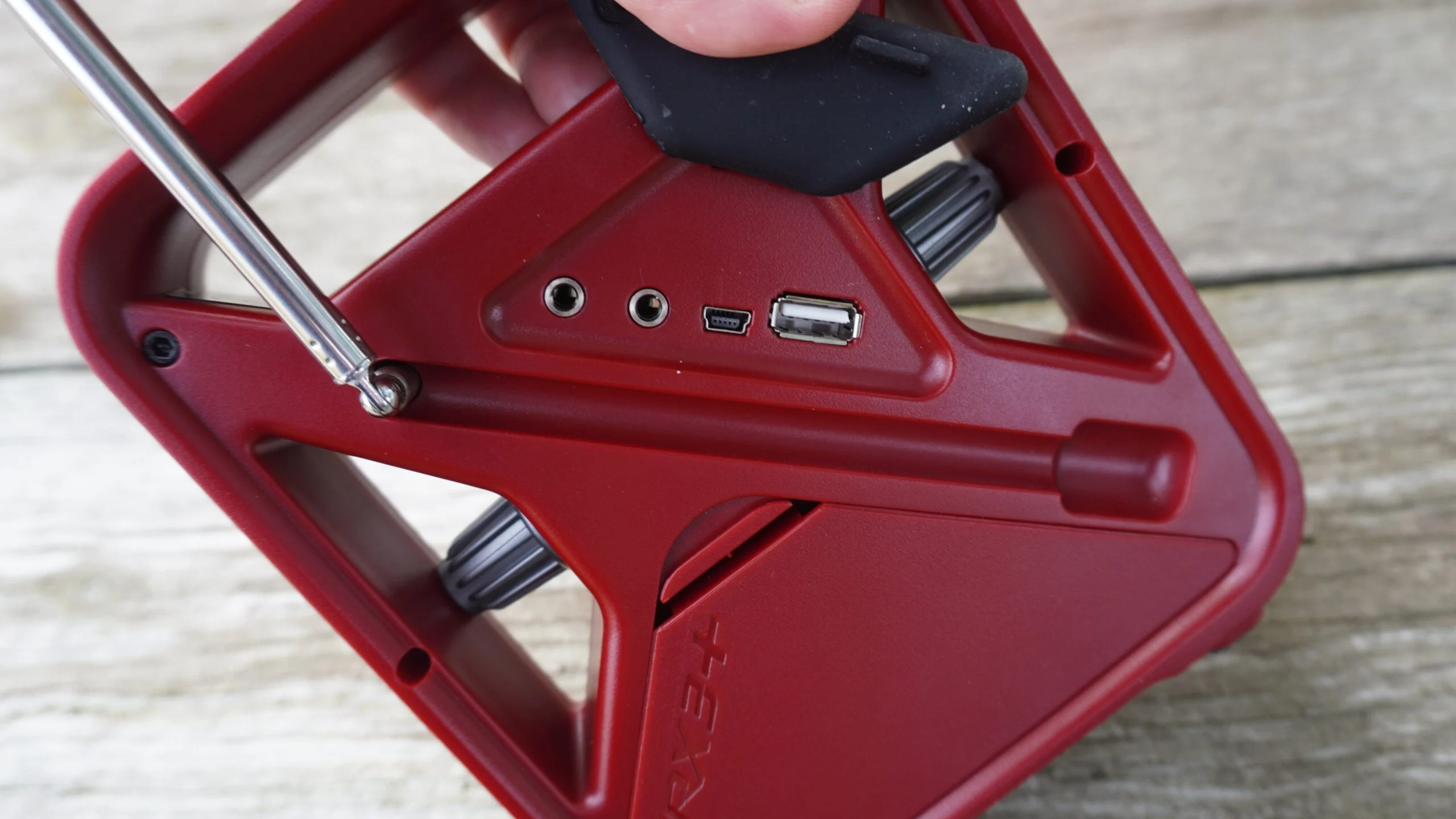
This radio can charge a cell phone rather efficiently but it can only do it while you’ve got it in “cell” mode. It’s a little frustrating you can’t listen to the radio while it does that. While I like the glow-in-the-dark locater feature on the top, the flashlight is on the smaller size.
Best Backpacking: Midland ER210 Emergency Weather Radio
Specs
Battery: 2600 mAh lithium battery
Power: Solar panel, hand crank, USB
Weather Features: NOAA radio, AM/FM radio
Additional Features: Flashlight, SOS beacon
Runtime: 24+ hours
Pros
Extremely compact
Durable design
Easy to tune
Cons
Molded loops feels unnecessary
Short antenna
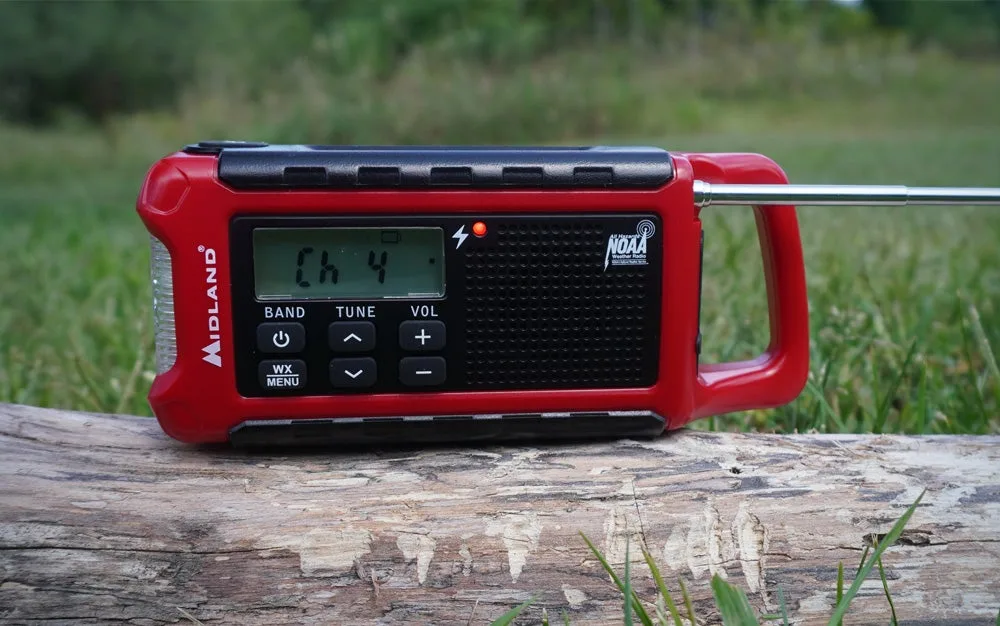
When deep in the backcountry, an emergency weather radio can keep you informed of the weather where cell signal is non-existent. I like the Midland ER210 for this scenario because it has a very small profile. It’s only about 7 inches long by 3 inches high and just over 2 inches wide. The hand crank folds down almost completely flush with the body of radio. There aren’t a lot of points where it will snag up on parts of a backpacking backpack. The weight also feels decent considering there’s a 2600 mAh power bank included inside. A small solar panel helps keep it going while far from civilization.
The sound quality of this radio is rather surprising as it outperformed every other radio on the list. The AM and FM stations come in quite clear and crisp with none of that “tinny” sound that often accompanies smaller speakers. Plus, the flashlight is surprisingly bright. The third setting is an automatic SOS beacon for emergencies.
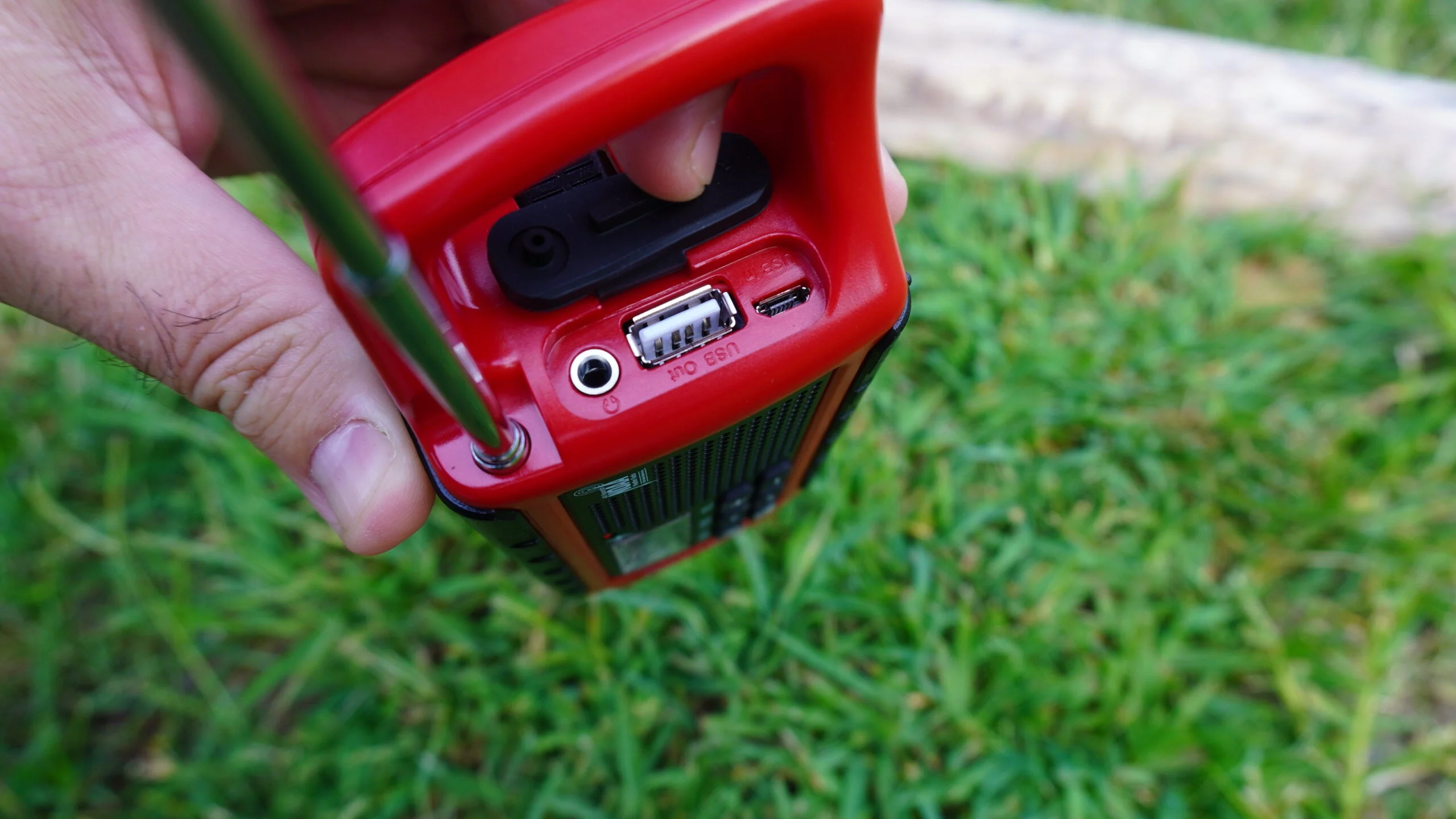
The antenna is a little short. It didn’t work well in my basement. However, outside it gets great reception. You shouldn’t have trouble getting updates from higher points. For $50, this radio offers a ton of features in a small package.
Best Budget: Uncharted Supply Co. NOAA Radio
Specs
Battery: 2200 mAh rechargeable lithium
Power: Solar and Hand Crank
Weather Features: 7-channel NOAA, AM/FM, SW radio
Additional Features: Alarm clock, earphone jack, integrated clip
Runtime: 12+ hours
Pros
Extremely light and compact
Battery lasts a long time
Easy to use crank
Cons
Short antenna
Issues with charging features

This nifty little radio came with my Decked/Uncharted emergency supply kit, but you can also buy it separately. I’ve found the hand crank charger on this radio works perfectly. Just crank it for a few minutes and you’re good to go. I’ve left this radio running in the background through a full eight-hour workday with no issues losing power. It has a shorter antenna than the others on this list. While it picked up FM signals just fine in my basement, I had to go upstairs to get the NOAA forecasts. That shouldn’t be an issue for anyone who lives in an area where basements aren’t the norm, though.
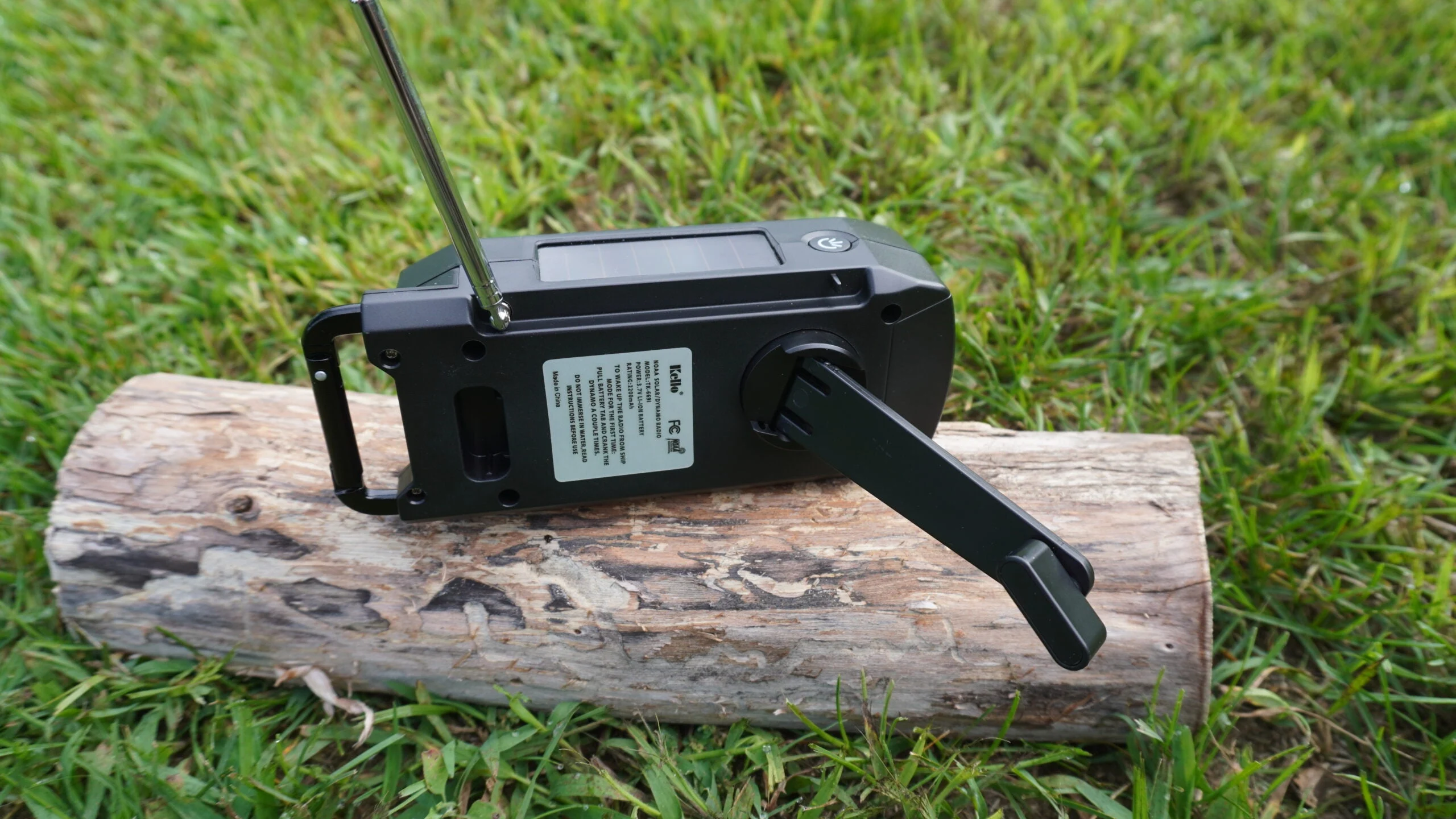
I had some issues with the phone charging features of this radio. They just flat out didn’t work on my model. But I don’t really see that as a downside because the basic light and radio features work so well. You don’t ever have to worry about batteries with this unit, and the size is compact enough for the smallest RVs and cars. I think this would be a good option if you’re looking to stock several homes and vehicles with an emergency weather device. It’s also a good option for an emergency kit because it takes up so little space.
Most Versatile: 4Patriots Liberty Band Emergency Solar Weather Radio
Specs
Battery: 600 mAh
Power: USB, hand crank, solar panel
Weather Features: Weather band alert, AM/FM radio
Additional Features: Short wave radio, flashlight, backpack clip
Runtime: 10 hours
Pros
Dual battery sources
Reinforced corners add durability
Great battery life
Cons
Slightly expensive

The battery on this radio is one of the smaller ones I tested. However, it has a rather unique feature in that there’s space to insert three AAA batteries. Add in the solar panel and crank, and there is no excuse to not get this radio running in an emergency. While this radio got a regular FM signal in my basement, it wouldn’t pick up the weather forecasts unless I was above ground level. This is probably a radio better suited for areas where people don’t use a basement for shelter.
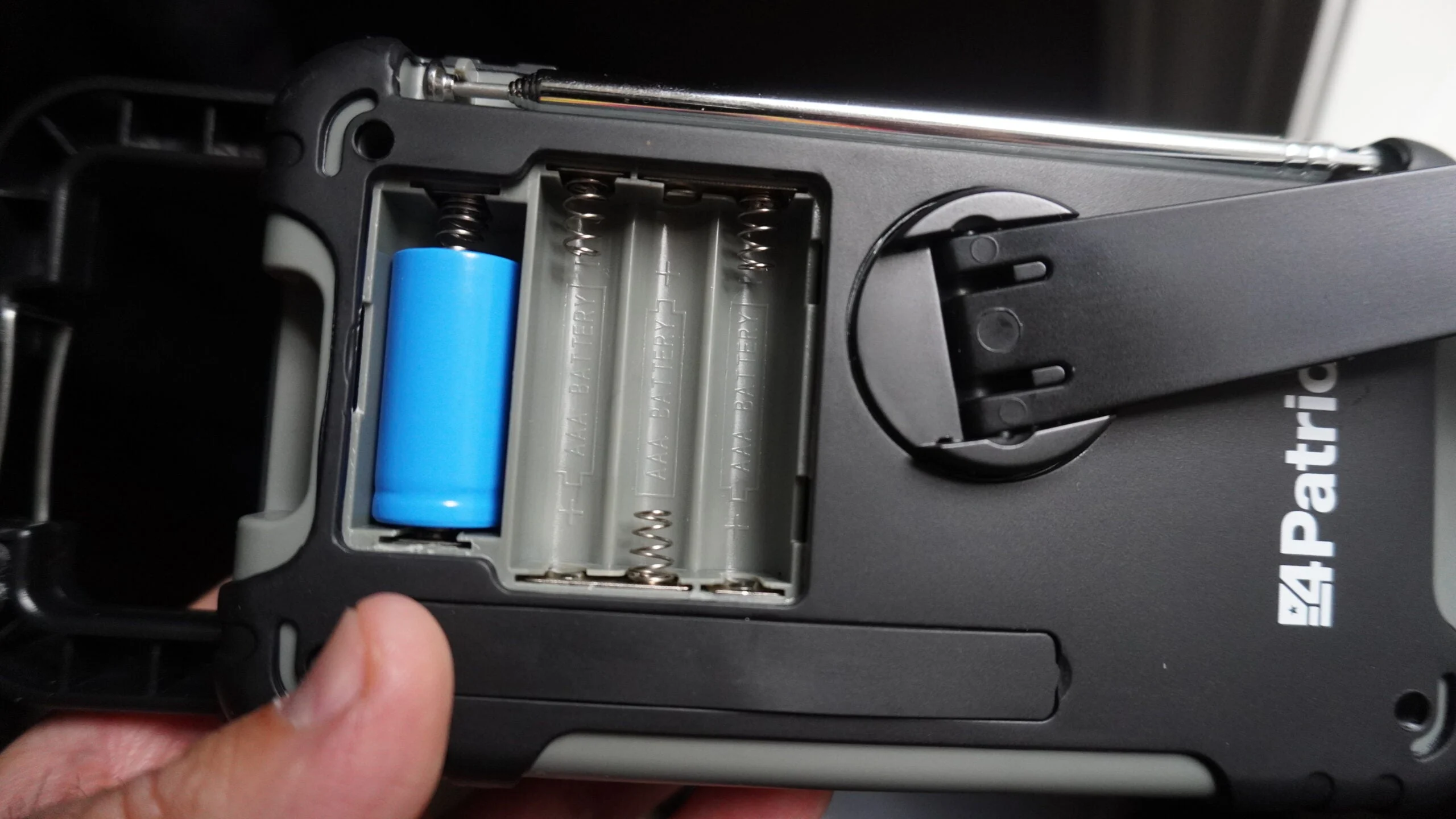
I like the buttons on this radio a little more than the tuning knobs on some other radios. It just helps to be more a little more precise in locking onto a signal from a station that’s in between frequencies. I also found it to be rather efficient on battery life. It ran for a solid 10 hours before it finally ran out of juice.
How We Tested Weather Radios
I thoroughly tested each of these weather radios because I’m a firm believer it’s best not to wait until disaster strikes before seeing if a piece of equipment really works. After making sure each radio had a full charge or fresh batteries, I ran all the radios continuously for at least 12 hours or until they died. I wanted to see what kind of runtime users can expect. For the testing of signal, I ran all the radios outdoors, indoors, and in my basement.

My goal with the basement test was to simulate taking shelter from a tornado or other severe weather. If the best weather radios can get signal in a basement, they should get a signal anywhere. I then evaluated the sound quality of each. I also considered the following factors:
Construction: How durable is the radio? Does it feel like it could handle a lot of abuse?
Flashlights: Does the radio have bonus lights? How bright are they?
Charging ports: Does the radio have USB ports? How well do they charge small electronic devices?
Value: Does the price make sense for the features offered by each radio?
What To Consider When Choosing a Weather Radio
With considering the best weather radios, the key feature to look for is one capable of receiving forecasts and alerts from the NOAA Weather Radio network. This information is gathered by the National Weather Service (NWS), which then broadcasts it using eight different stations. It’s important to note these broadcasts cannot be heard by a regular radio.
The forecasts are read by an artificial voice and are distributed 24 hours a day, seven days a week. They’re a little strange to listen to, but they’ll give you all the weather information you could ever need. And they’re usually more accurate than a cellphone app. I live about 30 miles from the shores of Lake Michigan, so my local broadcasts also include information on lake conditions, including surf warnings for dangerous waves and rip currents. If you’re looking for a radio specifically for emergencies, an NOAA radio is the way to go.
NWR S.A.M.E. Broadcasts
This acronym refers to specific area message encoding, which allows you to get county or township-specific weather alerts for a specific area of your choosing. It’s a nice feature to have, especially if you live in an area prone to tornadoes or other severe storms. Radios with this function will give off a high-pitched alert like the emergency broadcast system to alert you something is going on with the weather.
Depending on the radio, you may need to input a location code to the radio to start receiving SAME broadcasts. The method of doing this will vary based on the make and model of radio. However, the National Weather Service provides a handy listing of all the codes and counties on their website. Sometimes codes will be out of service, so it’s handy to check if you’ve already been using a code for years that suddenly stops working.
Power, Inputs, and Other Features
Compared to other electronic devices, weather radios usually offer an incredible amount of value and versatility because most are built to be multi-function devices that serve as more than just a way to get emergency information. All the models I tested have USB ports for charging cell phones and other compatible devices from an internal 2000 mah power bank. Some have power banks that are larger than that.
Many models now offer an integrated flashlight feature with bright LED bulbs that will brighten a dark room. I’ve seen some flashlights on these radios that rival dedicated lights of the same price.
Another common feature is a lithium-ion battery with multiple ways of charging it. Let’s face it, most of us probably do not check the batteries in our emergency supplies as often as we should. It’s a nice little peace of mind when you can quickly charge a weather radio with a hand crank.
Crank radios usually deliver about six minutes of run time for the radio feature for every minute you turn the crank. Alternatively, you’ll get around the same amount of runtime from built-in flashlights depending on the different flashlight settings. Higher brightness will obviously drain it faster.Many models now also feature a small built-in solar panel to keep running when all other power sources fail.
FAQs
Q: What are the seven frequencies for NOAA?
According to the National Oceanic and Atmospheric Administration (NOAA), their seven VHF public service band frequencies include 162.550 MHz, 162.525 MHz, 162.500 MHz, 162.476 MHz, 162.450 MHz, and 162.425 MHz. Most weather radios have a dedicated knob for cycling through these bands.
Q: Are crank radios worth it?
In my experience, crank radios are worth the cost. After all, it’s easy to forget to change out the batteries and have a radio that is completely dead in storage. But a crank radio allows you to quickly charge it back up and get relevant information in a hurry. It’s great when you cannot find the appropriate batteries, too.
Q: How do I get the best radio signal?
Make sure the radio’s antenna is fully extended. You might have to move it around to find the best position for a clear signal. It also helps if you can place the radio near an open window with a clear view of the sky. If that fails, try getting to a higher spot.
Final Thoughts
While I found that all these products were great at what they do, the Givoust NOAA radio stood out from the rest of the crowd as the best weather radio overall. It just has everything one could want in a battery-operated emergency radio: a bright flashlight, a gigantic internal battery, a built-in solar panel, and superior sound quality. Combine that with an excellent price point, and you’ve got a great weather radio that you can depend upon when the weather turns foul.
Why Trust Us
For more than 125 years, Field & Stream has been providing readers with honest and authentic coverage of outdoor gear. Our writers and editors eat, sleep, and breathe the outdoors, and that passion comes through in our product reviews. You can count on F&S to keep you up to date on the best new gear. And when we write about a product—whether it’s a bass lure or a backpack—we cover the good and the bad, so you know exactly what to expect before you decide to make a purchase.

